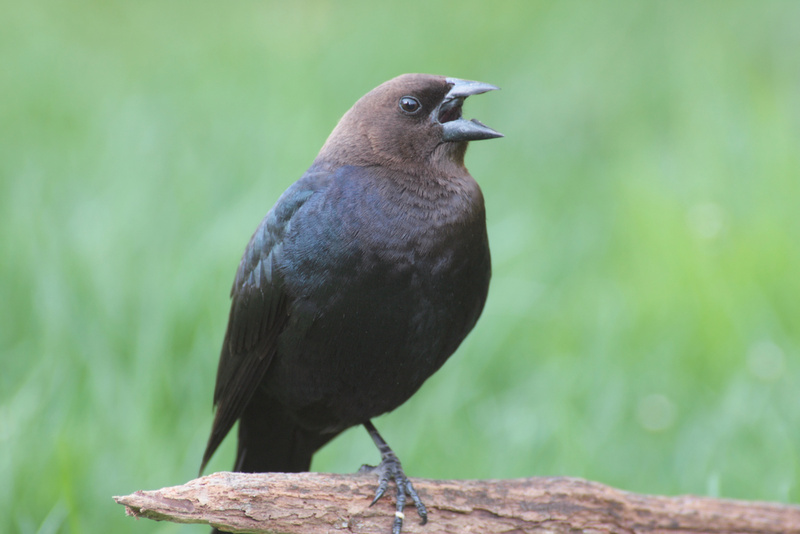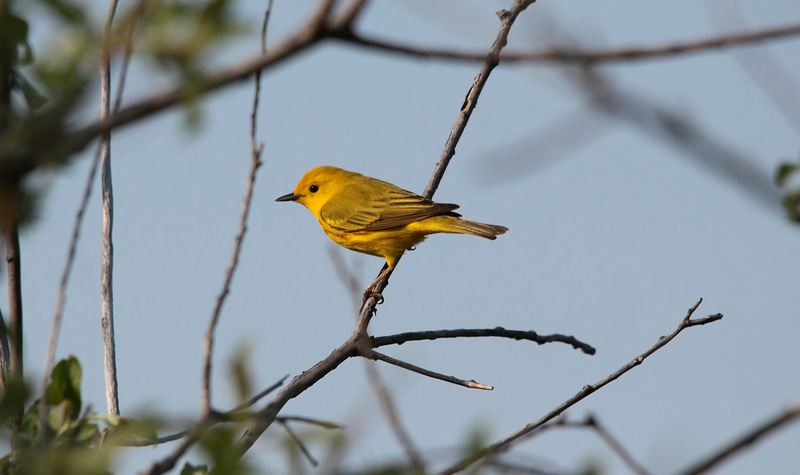Several scientific papers that recently appeared in ornithological journals deal with birds that occur regularly in Maine. Some of the research for the papers was performed in our state.
Melanie Guigueno and Spencer Sealy published a recent article in the Condor that examines the behavior of yellow warblers whose nests contain one or more brown-headed cowbird eggs.
The practice of laying eggs in the nests of other species of birds is a hallmark of the brown-headed cowbird. This sneaky trick, called brood parasitism, poses a huge conservation threat to many species of eastern birds. These cowbirds have only been in the east for less than two centuries. Prior to the European colonization of North America, brown-headed cowbirds were found on the western plains, following bison to feed on the insects the bison displaced while grazing.
With the conversion of Eastern forests to pasture land, habitat was created that allowed cowbirds to spread east. The various species of birds that are hosts to the cowbirds’ eggs and nestlings had no prior experience with cowbird brood parasitism and in many cases have not had time to adapt.
For species that are able to distinguish a cowbird egg from their own eggs, several behaviors are available to thwart the efforts of the cowbird to pawn off the rearing of her own young. Sometimes, a host grasps the cowbird egg in its bill and ejects the egg from the nests. This efficient method requires a fairly large bill (15 millimeters long). Unfortunately, the yellow warbler’s bill is too short. Some hosts will puncture a cowbird egg, pick it up with its bill and eject the egg over the side of the nest. Yellow warblers cannot do puncture-ejection.
However, yellow warblers do have a unique way of fighting back against cowbird brood parasitism. They construct part of a new nest (embedded burial) or an entirely new one (true burial) over the parasitized clutch of eggs and start the egg-laying process over again. Sometimes, the pair of yellow warblers will simply desert a parasitized nest and seek a new nesting site.
The authors studied 132 nests over 13 years. They found that burial of parasitized clutches occurred about two-thirds of the time and desertion was the strategy in the other cases.
We are fortunate in Maine to have two breeding species of sparrows that frequent salt marshes: Nelson’s sparrow and saltmarsh sparrow. Both were formerly united as a single species, the sharp-tailed sparrow. Saltmarsh sparrow has a more southerly distribution, breeding as far south as Virginia. Nelson’s sparrow along the Atlantic coast breeds from New Hampshire northward. In places like Scarborough Marsh, both species can be found in the same marsh, sometimes hybridizing.
Chris Hill and colleagues recently published an article in the Auk on saltmarsh sparrows. This species has an unusual life history compared to other sparrows. Males do not maintain a territory and do not form pair bonds with females. The males do not participate in the rearing of the young.
Using DNA comparisons, the researchers found that multiple partners were typical for female saltmarsh sparrows. Fifty-seven of 60 broods with at least two chicks resulted from females having two or more male partners. About a third of the broods had a different father for each chick. The most common result though was for one male to have fathered two or more but not all the chicks in a nest.
The males moved around in the salt marsh, siring chicks in nests up to a mile apart. The life history of this species is really quite different from the strongly territorial reproduction of related species like song sparrows.
A team of researchers including Maine ornithologists Tom Hodgman and Peter Vickery published a comparison of home range sizes and habitat use by Nelson’s sparrow and saltmarsh sparrows in the Wilson Journal of Ornithology. This work was done in Scarborough Marsh.
The researchers used radio-transmitters to track the movements of 63 Nelson’s and 77 saltmarsh sparrows. Like the saltmarsh sparrow, Nelson’s sparrows do not defend a breeding territory. However, they do tend to spend most of their time in particular areas, overlapping with individuals of both species. Theses areas are called home ranges rather than territories.
Using the location data from the radio-transmitters, the researchers found that the home range of male Nelson’s sparrows was over twice as large as that of male saltmarsh sparrows (300 acres compared to 125). Females of both species had similar home ranges of 70 to 100 acres.
Herb Wilson teaches ornithology and other biology courses at Colby College. He welcomes reader comments and questions at:
whwilson@colby.edu
Previous columns and other information on Maine birding can be found at his blog:
http://web.colby.edu/mainebirds/
Send questions/comments to the editors.




Success. Please wait for the page to reload. If the page does not reload within 5 seconds, please refresh the page.
Enter your email and password to access comments.
Hi, to comment on stories you must . This profile is in addition to your subscription and website login.
Already have a commenting profile? .
Invalid username/password.
Please check your email to confirm and complete your registration.
Only subscribers are eligible to post comments. Please subscribe or login first for digital access. Here’s why.
Use the form below to reset your password. When you've submitted your account email, we will send an email with a reset code.